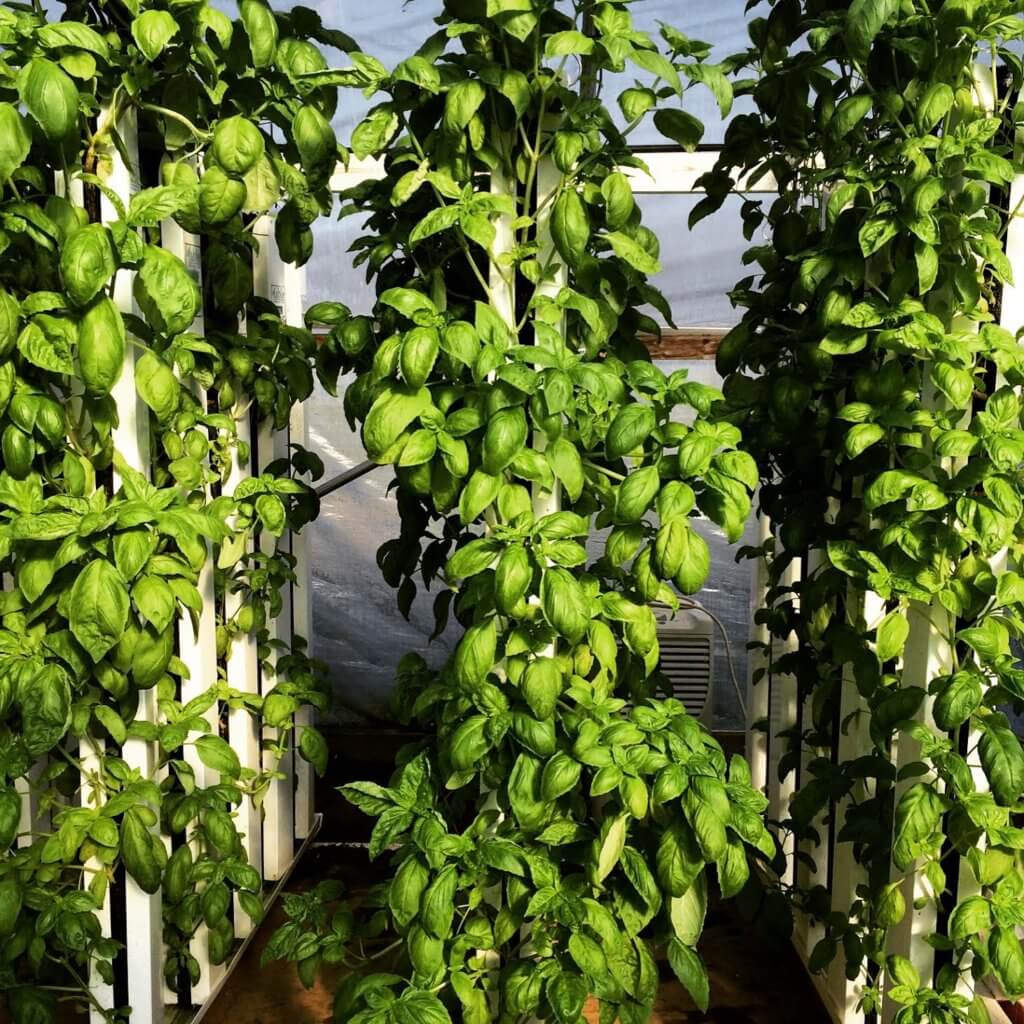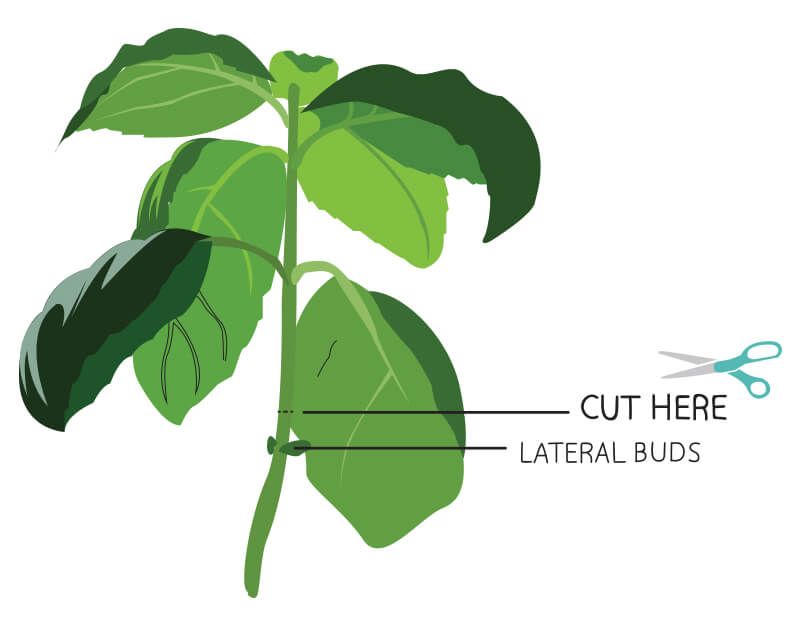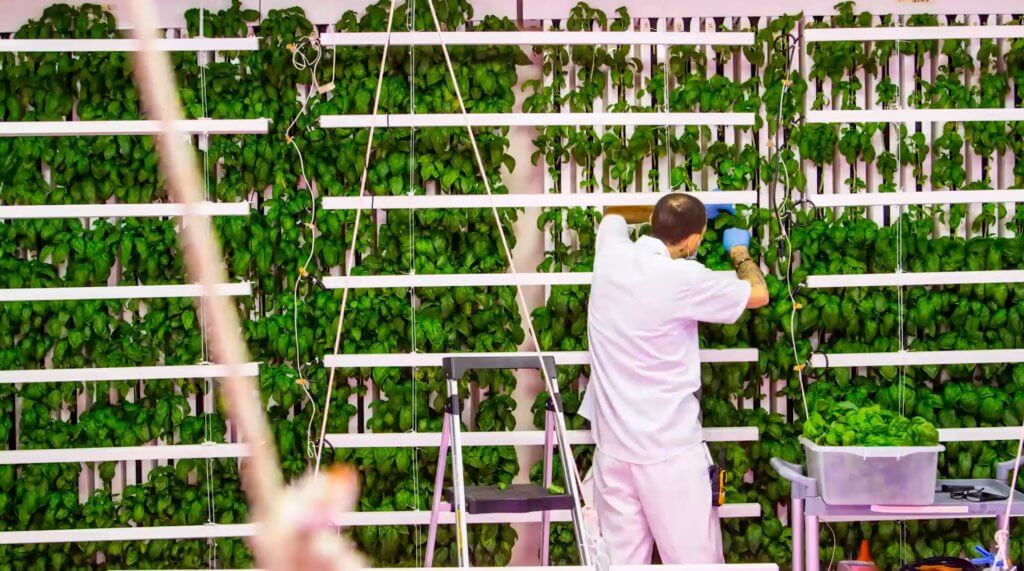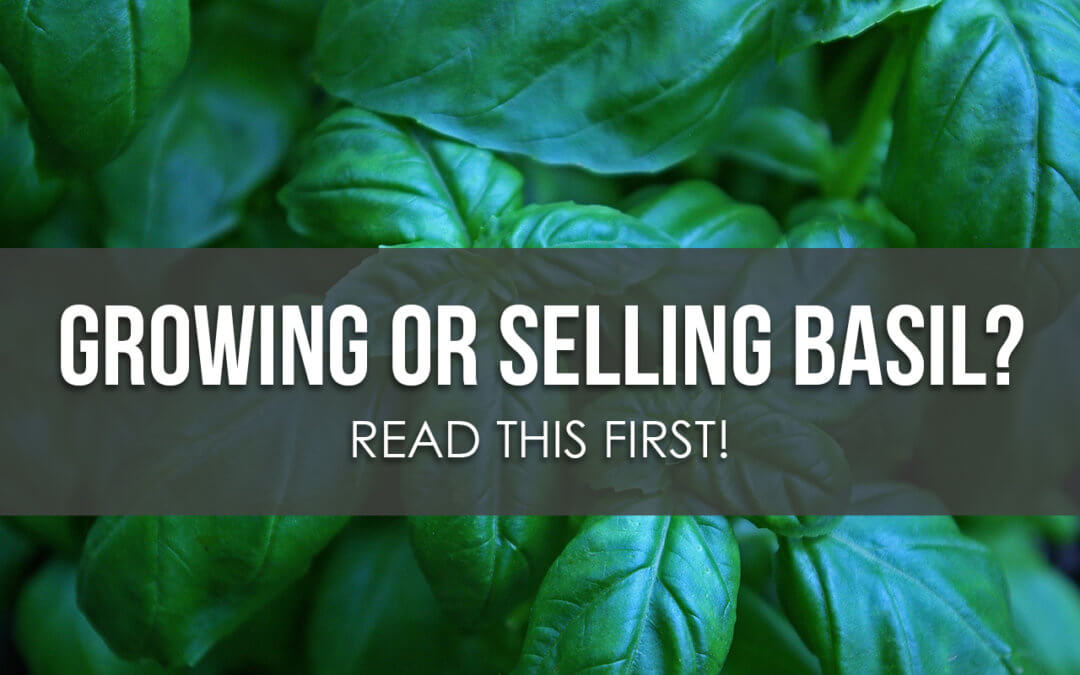
Dwarf basil in the first ZipGrow experimental greenhouse. Dwarf basil has smaller leaves and is bushier than most varieties.
Basil is a well-loved crop in almost every community.
The woody herb can be sweet, savory, or peppery, and it smells amazing. Basil has been used some way in almost every place in the world and has collected its own interesting history throughout the ages. (For a century or two, basil was thought to spawn scorpions.)
Basil belongs to the mint family (Lamiaceae), along with rosemary, oregano, thyme, and several other popular herbs.
Our favorite basil varieties are the classic sweet basil (Ocimum basilicum), Genovese basil, Thai basil, and dwarf basil. Sweet basil is a favorite among the Upstart Farmers.
Herbs are much more profitable than leafy greens, and can be a fantastic crop line for market growers. The pricing you receive will vary depending on your market. For example, Direct to Consumer markets like a CSA can often see prices as high as $2 or $3 an ounce, while wholesale markets like restaurants may land in the $1 to $1.50 an ounce range.
A recent price check at Target revealed that a 3/4 ounce clamshell package was retailing for $2.00, which comes out to $2.66 an ounce at the point of sale. A general rule of thumb is that wholesale pricing will be 40% to 50% of retail price.
Ideal conditions for hydroponic basil
- EC: 1.6–2.2
- pH range: 5.6–6.6
- Temperature: 65–95ºF
If mint scores a 1 in difficulty (it’s quite easy to grow), then woody herbs like basil are at the other end of the scale. Although basil isn’t needy in terms of water and pH, it does require pruning (see below) to achieve full yields and grows best in high temperatures which can be tough to match with other crops. When you can achieve ideal conditions, you’ll be amazed at the growth you can get from your basil crops.
Matt Marsh is a basil farmer in North Carolina. Over the last year, Matt has focused on growing high-quality basil for his community above other crops and has several tips for new basil growers.

- harvesting before bolting to flower
- throwing out any old/tough growth
- removing broken stems
Harvesting basil—how to cue apical growth

Basil grows at Fable: From Farm to Table
Basil has been bred to be a single-stemmed plant growing upward. For most growers, a bushier plant is better. A pruned plant looks better, yields more, and can be easier to transport depending on your growing method.
Upward growth is called apical growth. To change the way that basil grows, growers can trigger a secondary type of growth that moves outward and up instead of straight up. This is called lateral growth.
A young basil plant (say 5–10 inches tall), has buds on the side of the stem that haven’t grown out yet. Those are the lateral buds; they’re the back-ups that will only grow if the main stalk gets badly damaged or removed.
This means that if growers clip the stem right above those lateral buds (a half inch or so), the buds will be triggered to grow out. By pruning basil this way, growers can increase the production of that branch and control the shape of the plant.

When you go to harvest your basil for the first time, you’ll probably notice multiple pairs of lateral buds on the plant. Cut the plant above the second pair of buds. Matt explains why:
“We cut down to the second ‘Y’ in most cases. Any leaves above that split on the stem will be harvested. I used to cut down to the first ‘Y’ but it made the growth so tight that I had issues with moisture being held inside within the collection of leaves. So, moving out the second has fanned out the growth enough that it doesn’t stop airflow, light penetration, etc…”
If you prune a basil plant correctly, then you’ll see an increase in yield each time you harvest for the first three harvests (around weeks 5, 8, and 11).

Post-harvest care of basil
Several times now, we’ve had a conversation that goes like this:
“I brought a crate of basil cuttings to the chef at the restaurant I service. The next day, I got a call from him saying that the basil had gone bad! That’s impossible… I had just harvested it.”
Every time something like this happens, we ask, “did he put it in a cooler?” and always, the answer is yes. Usually, coolers are kept at 40–45º degrees, but basil doesn’t have the cellular machinery to deal with those temperatures. A few warm-weather crops respond to cold temperatures with rapid decay.
To extend the shelf life of basil, store it above 55º F (preferably at a temperature of 60º). At this temperature, it can attain a shelf life of 12 days. Instead of cooling the basil, keep it in a higher-temperature cooler, or on a counter in a cool room. For home consumers, a jar of water on a counter works great.
If growers package basil in bags or cartons that reduce moisture loss (plastic with little or no air exchange), be sure to keep storage temperatures steady to avoid condensation. Matt has had success with vented bags:
“We use vented bags and keep the basil out of sunlight at all costs! Our restaurants keep the bags in dry storage of some sort and most just hang the bags in the kitchen away from heat and certainly not in the cooler! If the restaurant has a wine cooler it is usually kept around 60–65ºF and can be a great place to store it.
“If we have issues with moisture in the bags, we will put a paper towel in the bottom but our best solution is to do 2 deliveries per week (only accounts at 2lb/wk or more). Costs us more but they never have bad basil.”
What if customers don’t listen to you and still store it in a cooler? Matt has solved this problem by providing a test bunch free of charge so that customers can see the results themselves.
“I’ve had stubborn customers who put the basil in a cooler and I’ll gift a bag of basil (usually .5 lb) and have them sit it out where I decide for a full week. Our record… 100% of them begin keeping the basil in that area after the test run.”
Handle basil gently, as bruising can increase the rate of deterioration. Many Upstart Farmers have found that selling basil packaged in clamshells is helpful for preserving the herb.
>>> Read more on tips for post-harvest care of herbs
Get ready. Get set. Grow.
Upstart Farmers can grow incredible basil to serve to their communities, and it’s definitely a worthwhile herb! Leave comments if you have questions, and don’t forget to check out our other crop posts.



Great article. Where have you found luck sourcing the vented bags?
Evan, glad this was helpful – thanks for reading!
Matt uses a local supplier for his harvesting supplies because he can try out new products quickly and saves himself time in researching each product. (He recommends this to new growers as well.) He actually just switched to a draw-string plastic bag because he can fit it into a 5-gallon bucket, harvest directly into the bag, and save labor time.
Hi Amy, is Matt still using the drawstring plastic bags? These could be very handy on our farm.
Hey Ryan, I believe so. If you’re looking for suppliers, I’d throw the question out in the Upstart U Community on Facebook. Other farmers might have recommendations.
Great article
The PDF document on sale on your website has other values for PH and EC. Are the ones on the blog the best one or the one in the PDF?
Thanks
Hi Maxime, thanks for the heads up on that inconsistency! These are a bit more conservative so stick with the ones here.
I have a question on how to read the reference cards…harvesting for basil is done 8-10 weeks from transplant or from seed? Not sure how the timeline should be read.
Hi Andy, it’s the age of the plant – so you can do the first harvest when it’s 8-10 weeks old. This usually ends up being about 6 weeks after transplant, depending on the conditions.
Thank you Amy!
Forgive my confusion, I am very new to this. We are in the works of developing our business plan and want to try and define a more accurate cost analysis/production estimates. We are working with some small restaurants and not sure of the scale to start at. In the Zipgrow production estimate pdf, the chart shows that at week 5 (on a 5-week turn) there is an estimated 3-4 lb harvest per tower. My question is, would you be constantly harvesting throughout the harvest life (5 weeks) of the plant or would you only have three total cuts? Thank you for your time in advance. You guys really are doing a great job providing very useful information.
Hey Raymond. The numbers in the estimates are for once only at the listed intervals, rather than a little bit each week.
Hi what do you recommend for your hydroponic system? Is it simple enough to build yourself or is there a prebuilt system you recommend?
Hi Ken, the type of system you use depends on your space, climate, and growing goals. There are several turnkey systems that work for basil as well as DIY-type systems. A Bato bucket system will be more hands-on, while a Farm Wall is more of a ready to go kit. If you’re tossing around pros and cons of different growing techniques, I recommend the “Choosing Your Production Technique” course.
The pH range in this blog does not match the pH range on the “Reference Card: Basil” (.pdf)
Hey Tylor,
The 5.6–6.6 is just a more conservative range. We recommend that one.
Hi, I’m having some trouble understanding the timeline 🙁
Is this correct? On day one the seed goes into the plug. 7-10 days later the seed germinates. 3-5 weeks in the seedling is transplanted into the tower. 8-10 weeks in is the first harvest. Then every 3-5 weeks is another harvest from the plant. If this is the case, how long on average does that plant stay in the tower? Thanks!!
Hi Matt,
The variation in the timeline for this is due to the fact that there are many different varieties of basil, each with their own grow timelines. Some will be much faster (F1 hybrids), heirlooms are typically slower. The short answer is that most varieties will see a max of 3 harvest cycles (and some choose to only do a single cut harvest).
We have not been growing basil due to the fear of being stuck with excessive amounts at harvest. We concentrate on distributor/wholesale market and large volume/demand crops. Is it difficult to get high-production basil to a distributor chain or do they tend to buy low volume as well? I find it much too expensive for larger operations to grow small volume niche products. It is more practical I think to get agreements for large orders that can be planned on a routine basis via a distributor.
Good day
We are from south africa working on Aeroponics to grow basil.
My question is, what is the yield per plant on hydroponics and is there much of a difference using Aeroponics?
Roche
What is the nutrient program for the sweet basil
Hi Dev,
Try an herb formula like this one from Chem-Gro.
Hello Amy,
Would you be willing to share where Matt got those squarish white pipes? Im in Philippines and I dont seem to see them in the hardware stores near me. Are these some sort of specialized pipes?
Secondly, that simple pruning tip (second “Y” area) gives me a relief. I’ve been too scared to prune my basils as I thought it would hurt them.
Thank you.
-Nancy-
Hi Nancy,
Those are ZipGrow Towers! I’m glad you like them—you may purchase them at zipgrow.com. I hope your basil is doing well.
Ohhh, “zipgrow”. Ok Mia, I’ll search for this one. I hope this could help me scale-up my basil garden.
Thanks a lot.
-Nancy-
Nice article showing the full process. Basil post-harvest handling is key but no post-harvest treatment can prevent an issue that starts in the field such as botrytis, etc
Hello Amy,
First of all, I would like to thank you for your great article and I must say it very helpful for someone who just started their own system.
I’m wondering what kind of fertilizer are you using for basil? We have started our project with my best friend 6 months ago but our plants don’t taste right. Do you have any tip or advise what we can add to the water to make our plants happier and tastier?
Thank you very much.
Kind Regards
Lukas
Hi Lukas,
Take a look at Hydro-Garden’s Chem-Gro formulas.
I am having problems with my basil tasting bitter, especially thai basil (which is my favorite). I am confused about the proper nutrients. The hydro-Garden’s Chem-Gro PEPPER & HERB FORMULA 11-11-40 says: “When this formula is used for Herbs, reduce the above recommendations to 1/2 strength and adjust Nitrogen (N) to desired level with
Potassium Nitrate (KNO3) and Calcium Nitrate (CaNO3). What amount do I adjust it to? In my research, they all say something slightly different. I am using the Masterblend 4-18-38 Tomato Formula at 84% strength and added Calcium Nitrate & Epson Salt (2:1 ratio), but then read that basil needs more mag. Please help.
Hi! Thank you for this helpful article. How will I know that it is time to replace the basil plant?
Hi,
I’m wondering how many plugs in a 8′ zipgrow tower can be put for the optimum yield.
Kind regards,
Çağrı
and the result weight for each harvest/tower in a warehouse indoor farm with a controlled environment
Love the detailed instructions on how to prune your basil plant! This is super helpful, and hard to find!
That’s a great reading so far on hydroponic basil. I do agree with “Basil post-harvest handling is key”. I appreciate you for this write-up. Thanks and keep it up!
Great article! I always wondered why herbs are such a profitable crop compared to other leafy greens. What market dynamics are creating these higher pricing for herbs?
Hi,
This is a great article and really helpful for my hydroponic basil plants. There is only one thing i am struggling with and i hope that someone knows what the best NPK ratio is for hydroponic basil.